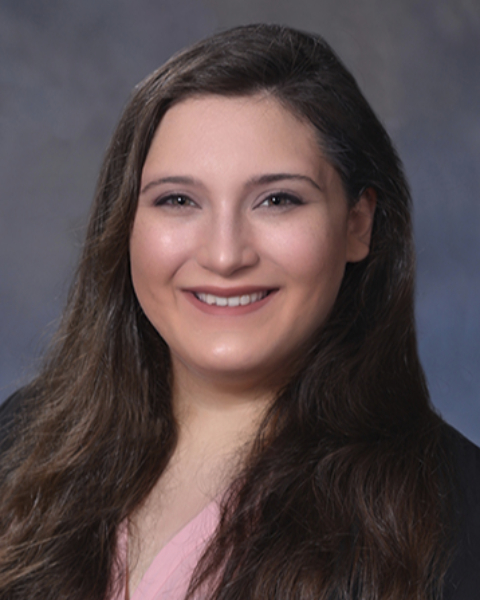PQA 05 - PQA 05: Breast Cancer and Nonmalignant Disease Poster Q&A
2676 - Do Standard Tangents Cover High-Risk Nodes among Patients with Breast Cancer Undergoing Neoadjuvant Chemotherapy?
Monday, September 30, 2024
3:00 PM - 4:00 PM ET
Location: Hall C
Screen: 1

Madeline Flanagan, MD
Baylor College of Medicine
Houston, TX
Presenter(s)
M. M. Flanagan, A. Arenas, M. S. Ludwig, S. Sharma, K. Morales-Rivera, R. Brown, and C. H. Chapman; Department of Radiation Oncology, Dan L. Duncan Comprehensive Cancer Center, Baylor College of Medicine, Houston, TX
Purpose/Objective(s): Standard breast tangents provide variable coverage of axillary levels I/II. However, standard tangents might provide optimal coverage for high-risk areas, including biopsy-proven clipped and other suspicious nodes among clinical N1 patients undergoing neoadjuvant chemotherapy (nCT). Some radiation oncologists already intend to omit regional nodal irradiation (RNI) among NSABP B51-eligible patients who achieve a nodal pathologic complete response (nPCR) after nCT. However, B51 subset analyses raise the question of whether the mastectomy (vs. lumpectomy) cohort indeed benefited from radiotherapy (RT) as delivered on trial. The no RNI arm of the mastectomy cohort received no RT, which differed from the lumpectomy cohort which received some level I/II RT via standard tangents. The possible numeric difference in recurrence among the mastectomy (vs. lumpectomy) cohort raises the question of whether coverage of level I/II areas via standard tangents is required to sufficiently reduce regional recurrence. In cN1 patients, regional recurrences may occur adjacent to the clipped node or in other suspicious intact nodes, especially with increasing sentinel lymph node biopsy use. We hypothesize that, among cN1 patients, standard tangents cover high-risk sites (e.g., clipped node and additional suspicious level I/II nodes) most of the time. Materials/
Methods: We identified a cohort of cT1-3N1 patients, stratified by nPCR. We used diagnostic chest CTs to identify the clipped and other suspicious nodes (suspicious per radiology report). For individual patients, we reproduced the tangent geometry onto diagnostic CT. We determined whether the clipped and other suspicious nodes were within the tangents anteriorly and were >= 2.7cm inferior to the humeral head (2cm for standard high tangent definition and another 0.7cm for penumbra).
Results: Thirty-six patients treated 2021-2022 were eligible, and 30.6% had an nPCR. Standard tangents covered the clipped node in 83.3%, including 81.8% with and 84.0% without an nPCR. The clipped node was posterior to the tangents in 2.8% of cases and was <2.7cm of the humeral head (i.e., would have required high tangents or third field) for 16.7% of cases. In 30.6% of cases, there were additional suspicious nodes present which were not covered by standard tangents.
Conclusion: Standard tangents covered the region of the clipped node and other suspicious nodes in most cT1-3N1 patients at our institution. This suggests that even without the use of high tangents or a supraclavicular field, high-risk nodal regions are frequently covered among cN1 patients, including those who convert to ypN0 and would have been NSABP B51 eligible. Future studies should help elucidate whether mastectomy patients, in whom RT would be omitted entirely per B51, might benefit from the focused axillary coverage delivered via standard tangents.
Purpose/Objective(s): Standard breast tangents provide variable coverage of axillary levels I/II. However, standard tangents might provide optimal coverage for high-risk areas, including biopsy-proven clipped and other suspicious nodes among clinical N1 patients undergoing neoadjuvant chemotherapy (nCT). Some radiation oncologists already intend to omit regional nodal irradiation (RNI) among NSABP B51-eligible patients who achieve a nodal pathologic complete response (nPCR) after nCT. However, B51 subset analyses raise the question of whether the mastectomy (vs. lumpectomy) cohort indeed benefited from radiotherapy (RT) as delivered on trial. The no RNI arm of the mastectomy cohort received no RT, which differed from the lumpectomy cohort which received some level I/II RT via standard tangents. The possible numeric difference in recurrence among the mastectomy (vs. lumpectomy) cohort raises the question of whether coverage of level I/II areas via standard tangents is required to sufficiently reduce regional recurrence. In cN1 patients, regional recurrences may occur adjacent to the clipped node or in other suspicious intact nodes, especially with increasing sentinel lymph node biopsy use. We hypothesize that, among cN1 patients, standard tangents cover high-risk sites (e.g., clipped node and additional suspicious level I/II nodes) most of the time. Materials/
Methods: We identified a cohort of cT1-3N1 patients, stratified by nPCR. We used diagnostic chest CTs to identify the clipped and other suspicious nodes (suspicious per radiology report). For individual patients, we reproduced the tangent geometry onto diagnostic CT. We determined whether the clipped and other suspicious nodes were within the tangents anteriorly and were >= 2.7cm inferior to the humeral head (2cm for standard high tangent definition and another 0.7cm for penumbra).
Results: Thirty-six patients treated 2021-2022 were eligible, and 30.6% had an nPCR. Standard tangents covered the clipped node in 83.3%, including 81.8% with and 84.0% without an nPCR. The clipped node was posterior to the tangents in 2.8% of cases and was <2.7cm of the humeral head (i.e., would have required high tangents or third field) for 16.7% of cases. In 30.6% of cases, there were additional suspicious nodes present which were not covered by standard tangents.
Conclusion: Standard tangents covered the region of the clipped node and other suspicious nodes in most cT1-3N1 patients at our institution. This suggests that even without the use of high tangents or a supraclavicular field, high-risk nodal regions are frequently covered among cN1 patients, including those who convert to ypN0 and would have been NSABP B51 eligible. Future studies should help elucidate whether mastectomy patients, in whom RT would be omitted entirely per B51, might benefit from the focused axillary coverage delivered via standard tangents.
